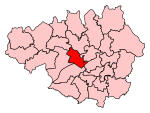Station Road, Swinton
1929 establishments in England1992 disestablishments in EnglandDefunct rugby league venues in EnglandDefunct sports venues in Greater ManchesterDemolished sports venues in the United Kingdom ... and 5 more
Rugby League World Cup stadiumsSports venues completed in 1929Sports venues demolished in 1992Swinton, Greater ManchesterUse British English from August 2015

Station Road was a stadium in Pendlebury, near Manchester, England. It was the home of Swinton Rugby League Club between 1929 and 1992 and was widely recognised as one of the finest grounds in the Rugby League. Swinton moved to Station Road when they were at their peak, having won all four major trophies ("All Four Cups") the previous season, one of only three clubs (the others being Hunslet and Huddersfield) ever to do so. The decision to purchase the land, which stood alongside the railway line and Swinton railway station, was made after a breakdown in negotiations with their existing landlord at their Chorley Road ground, their home since 1887.
Excerpt from the Wikipedia article Station Road, Swinton (License: CC BY-SA 3.0, Authors, Images).Station Road, Swinton
The Gateways, Salford Newtown
Geographical coordinates (GPS) Address Nearby Places Show on map
Geographical coordinates (GPS)
| Latitude | Longitude |
|---|---|
| N 53.51504 ° | E -2.3344 ° |
Address
The Gateways
The Gateways
M27 6LA Salford, Newtown
England, United Kingdom
Open on Google Maps







